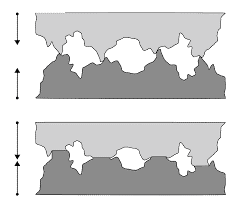Friction is the force that impedes bodies in motion.
Frictional force is evident when moving parts don’t move as freely as they should. When we attempt to ease friction, we quickly recognize it isn’t such a simple force. Friction is a machine’s number one adversary. It is generally accepted that one third of the world’s energy production is used in reducing friction.

A lubricant’s fundamental function is to help overcome this friction. The picture shows a close up of two metal surfaces. Notice the “peaks” and “valleys”. The peaks are called asperities. Without lubrication to keep them separated, the moving surfaces will rapidly begin to heat up, causing the metal to expand. The expansion then allows the opposing asperities (peaks) to contact each other.
Eliminate these damaging frictional forces
To eliminate these damaging frictional forces the metal surfaces must have enough separation to allow each surface to move over each other without “peak to peak” contact of asperities.
Remember, that friction causes heat which causes expansion. This expansion causes the high points to come into contact and break away causing wear. Wear particles become small cutting tools causing chatter, vibration, and more heat. To fight friction, we must perform proper lubrication practices.











